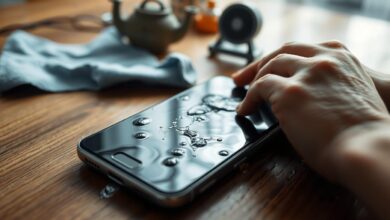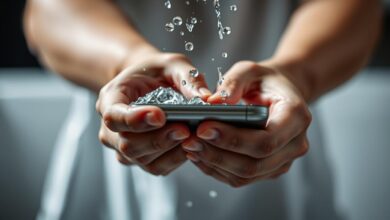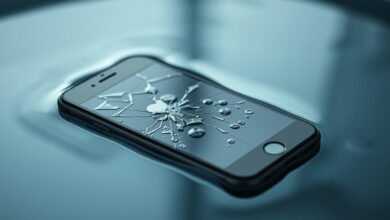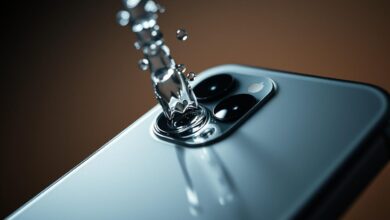water out of speaker
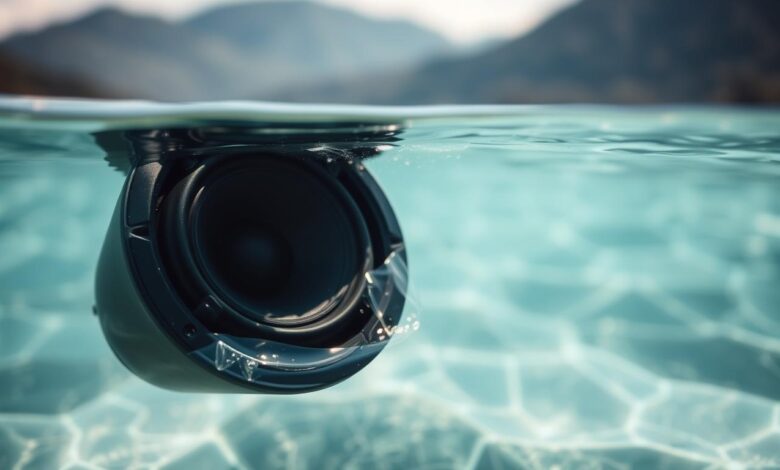
Ever spilled water on your phone’s speaker and got muffled sound or silence? Water can really mess up your phone’s sound. It might even stop working altogether.
But, there’s hope. You can get water out of your speaker. A tool at Fix My Speaker uses sound waves to push water out. It works by making special sounds that help dislodge water.
Act fast to avoid bigger problems. In this article, we’ll look at why water harms speakers and how to fix them.
Key Takeaways
- Water ingress can cause significant damage to phone speakers.
- Using sound waves is an effective method to remove water from speakers.
- Prompt action is necessary to prevent long-term damage.
- Regular cleaning of phone speakers is essential for maintaining sound quality.
- Fix My Speaker is a useful tool for removing water from phone speakers.
The Science Behind Water and Speakers
Water can really mess with speakers. They work by turning electrical signals into sound waves. But, when they get wet, their performance can drop a lot.
How Speaker Components React to Moisture
Moisture can harm speaker parts. The diaphragm, voice coil, and magnet are key. Water can rust metal, damage the diaphragm, and mess up the voice coil. This can ruin the sound or even break the speaker.
Why Water Damage Is Particularly Harmful
Water damage is bad for speakers. It can cause problems right away and later on. Right away, it can lead to corrosion and short circuits. Over time, it can cause rust and mineral buildup. It’s important to dry the speaker well after it gets wet.
| Component | Effect of Water | Drying Method |
|---|---|---|
| Diaphragm | Material degradation, reduced sound quality | Air drying, desiccants |
| Voice Coil | Corrosion, disrupted functionality | Gentle heating, dry environment |
| Magnet | Rust, weakened magnetic field | Drying with silica gel, avoiding moisture |
Knowing how water affects speakers is important. It helps us protect them and fix them if they get wet. By acting fast and using the right methods, we can reduce damage and get the speaker working again.
Common Causes of Water Out of Speaker
Knowing why water gets into a speaker is key to avoiding damage. Water can get in through different ways, harming the speaker’s sound quality.
Accidental Submersion
One big reason for water damage is when a speaker gets dropped into water. This can happen in a bathtub, pool, or any water. The shock can damage the speaker’s parts beyond repair.
Condensation Issues
Condensation is another big problem. It happens when the temperature changes a lot. Moisture in the air then forms inside the speaker. This can damage the speaker over time.
Humidity and Environmental Factors
High humidity and certain places can also cause water damage. Places with lots of humidity or using speakers there can be risky. Being near water or in the rain can also let water in.
To keep your speaker safe from water damage, know these risks. Understanding them helps you protect your speaker from water.
Signs Your Speaker Has Water Damage
Spotting water damage in your speaker is crucial. Water can harm the inside parts, messing with sound quality and how well it works.
Audio Distortion and Quality Changes
A drop in audio quality is a common sign. You might hear distortion, muffled sounds, or less volume. If your speaker doesn’t sound as good as before, water might be the culprit.
Visible Moisture Indicators
Moisture signs are clear indicators too. Look for condensation under the screen or in the speaker grills, or any water droplets inside. If your speaker got wet, check for moisture.
Functionality Problems
Water damage can also cause problems with how it works. You might see intermittent operation or it won’t turn on at all. If your speaker isn’t working right, water might have damaged the electronics.
- Check for distortion or changes in sound quality.
- Inspect for visible signs of moisture.
- Monitor for functionality issues.
If you see these signs, act fast. Quick action can help fix speaker water damage and prevent more harm. Use the right repair or drying methods.
Immediate Steps When Water Gets Into Your Speaker
When you see water in your speaker, you must act fast. This is to stop more damage and maybe save your device.
Power Down Immediately
Right away, turn off your speaker if you see water. It’s key because a wet speaker can cause short circuits. This can lead to serious damage. Unplug it to avoid electrical shock or more harm.
Remove Batteries If Possible
If your speaker runs on batteries, take out the batteries fast. This stops short circuits when batteries are connected. For speakers with fixed batteries, make sure it’s off and unplugged.
Initial Water Extraction Techniques
To start removing water, gently tilt your speaker. This lets gravity help pull out the water. You can also use a soft cloth or paper towel to dry the outside.
It’s vital to move fast and carefully with water and electronics. By following these steps, you can lessen the chance of permanent damage to your speaker. For a detailed guide on how to get water out of your speaker, see the next sections.
How to Get Water Out of Speaker: Step-by-Step Guide
Removing water from your speaker needs a careful plan. Quick action is key to avoid damage. Here’s how to dry your speaker effectively.
Positioning Techniques to Drain Water
Start by placing your device to help water drain. Turn it upside down to let gravity pull the water out. If water got in through the grill, tilt it so the grill is down.
Key positioning tips:
- Turn the device upside down to let gravity assist in draining water.
- Remove any cases or covers that might be obstructing the speaker grill.
- Gently shake the device to help dislodge water, but avoid vigorous shaking that could cause further damage.
Using Gravity to Your Advantage
Gravity can help remove water from your speaker. Position your device to let gravity guide the water out. Try placing it at an angle to help water flow.
Gentle Tapping Methods
Gentle tapping can dislodge water inside the speaker. Use a soft cloth or finger to tap around the grill. This loosens water droplets. But, be careful not to tap too hard to avoid damage.
For tougher water removal, like in smartphones, check out guides on how to get water out of your phone. Some methods might work for speaker water damage too.
By following these steps, you can remove water from your speaker. This might fix speaker water damage. Remember, be gentle and patient to avoid more damage.
Using Sound Frequencies to Expel Water
Using sound frequencies is a great way to get water out of your speaker. It uses sound waves to push water out of the speaker’s parts.
How Low-Frequency Sounds Force Water Out
Low-frequency sounds are very good at getting water out of speakers. They make vibrations that push water off the speaker’s surface and inside parts. A study on CNET shows how low-frequency sounds can clear water from iPhone speakers.
Apps Designed for Water Ejection
There are apps that make the right sound frequencies to get water out of speakers. These apps work on both iOS and Android. Some popular ones include:
- Sound Frequency Generator apps
- Water Eject apps
- Speaker Cleaner apps
Creating Your Own Water-Ejecting Tones
If you can’t find an app you like, you can make your own tones. You can use online tools or software like Audacity. Frequencies between 20 Hz to 200 Hz work best for getting water out.
| Frequency Range | Effectiveness |
|---|---|
| 20 Hz – 50 Hz | Highly Effective |
| 50 Hz – 100 Hz | Moderately Effective |
| 100 Hz – 200 Hz | Less Effective but Still Useful |
“Using sound frequencies to remove water from speakers is an innovative and often effective method. It’s a technique that leverages the physical properties of sound to solve a common problem faced by many smartphone and speaker users.”
Learning how to use sound frequencies can help you get water out of your speaker. This method, along with other drying techniques, can help save your speaker from damage.
Drying Techniques for Water-Damaged Speakers
To save your speaker from water damage, using the right drying techniques is key. Water damage can harm both the inside parts and sound quality. The drying process is vital to see if your speaker can be fixed.
Air Drying Methods
A simple way to dry a water-damaged speaker is air drying. Just let it sit in a dry, well-ventilated spot. Turn off the device and take off any accessories to help dry it. But, air drying might not work well for serious water damage.
Using Desiccants Effectively
Desiccants, like silica gel packets, can help dry out a wet speaker. Place them near the speaker to soak up moisture. But, make sure the desiccant doesn’t touch the speaker’s parts to avoid more harm.
The Rice Method: Facts and Myths
The rice method, where you soak the device in rice, is a common fix. But, it’s not always the best for speakers. Rice can soak up moisture, but it might not be the safest choice. Rice dust could get into the speaker and cause more problems. This method might not work well for big water damage.
In summary, drying a wet speaker needs careful thought about the best method. You can try air drying, using desiccants, or other methods. The important thing is to act fast and carefully to lessen damage and maybe save your speaker.
Device-Specific Water Removal Techniques
Removing water from speakers needs special techniques for each device. Each device has its own design and parts. So, we need different ways to get rid of water.
Smartphone and Tablet Speakers
Smartphones and tablets are small, making it easy for water to get stuck. To fix this, tap the device on a hard surface with the speaker down. You can also use a sound tone to help push out the water.
Bluetooth Portable Speakers
Bluetooth speakers have more room for water. Place the speaker so gravity helps push the water out. Also, using desiccants or silica gel packets can soak up the moisture.
Home Entertainment System Speakers
Speakers in home systems might need more work. You’ll have to take off the outer part to see and dry the inside. Use a soft brush or cloth to wipe away any water.
| Device Type | Recommended Water Removal Technique |
|---|---|
| Smartphone/Tablet | Gently tap on a hard surface, use low-frequency sound |
| Bluetooth Portable Speaker | Use gravity for drainage, desiccant or silica gel packets |
| Home Entertainment System | Disassemble, inspect, and dry components, use soft brush or dry cloth |
Testing Speaker Functionality After Water Exposure
Checking if your speaker works after water damage needs careful steps. Water can harm sound quality and how well it works. So, it’s important to test it safely to avoid more harm.
Safe Testing Procedures
First, make sure your speaker is turned off completely. If it has batteries, take them out or unplug it. Look for any damage or rust on the speaker. Clean it with a soft cloth, but avoid harsh chemicals or rough materials.
Evaluating Sound Quality
When it’s safe to turn it on, start with a low volume. Slowly increase the volume to check for any bad sounds. If you hear crackling or buzzing, it could mean water damage.
Identifying Residual Water Issues
If your speaker doesn’t sound right or keeps distorting, water might still be inside. You might need to dry it again or get it fixed by a pro.
| Test | Expected Outcome | Potential Issue |
|---|---|---|
| Power On/Off | Normal operation | Failure to turn on/off |
| Volume Test | Clear sound at all volumes | Distortion or no sound |
| Sound Quality | No crackling or buzzing | Unusual sounds |

By testing your speaker carefully after water damage, you can see how bad the damage is. This helps you figure out the best way to fix speaker repair water damage.
DIY Repairs for Water-Damaged Speakers
Fixing a water-damaged speaker is easy and can save you money. It also helps reduce electronic waste. It’s important to act fast to protect your speaker’s parts.
Cleaning Corrosion
To start, clean off any corrosion from water damage. You’ll need a soft-bristled brush, white vinegar, and a dry cloth. Brush off debris, then use vinegar on a damp cloth to clean corroded spots. Be careful not to use too much liquid.
Replacing Basic Components
Some parts, like speaker cones or wiring, might need to be replaced. Find the damaged parts and get new ones from the maker or a third-party supplier. Make sure the new parts fit and sound quality stays good.
Reassembly Best Practices
After cleaning and replacing parts, reassembling is key. Dry all parts well before starting. Follow the maker’s instructions or online guides for your speaker. Use the right tools and make sure connections are tight.
To fix speaker water damage well, be careful and detailed. Whether it’s a phone speaker or a big home system, the steps are similar. For tricky repairs, getting help from a pro is a good idea to avoid more damage.
By being careful and following these steps, you can fix your speaker and enjoy great sound again.
- Act quickly to minimize water damage.
- Use appropriate materials for cleaning corrosion.
- Ensure replacement parts match original specifications.
- Follow manufacturer guidelines for reassembly.
When to Seek Professional Repair Services
Not all water damage can be fixed by yourself. Sometimes, you need a professional. If your speaker got a lot of water or keeps having problems, it’s time to get help.
Signs of Severe Water Damage
Severe water damage shows in many ways. You might see persistent audio distortion, complete loss of sound, or visible corrosion. If you see these signs, stop using the speaker right away to avoid more damage.
Other signs include unusual noises or intermittent functionality. In these cases, a pro needs to check it out. They can tell you how bad it is and what to do next.
Finding Qualified Repair Technicians
To find a good repair tech, start with the manufacturer’s website. They list authorized service centers. You can also ask friends or family for recommendations. Make sure the tech knows how to fix water-damaged speakers and can give you a clear plan and price.
Cost Expectations for Professional Repairs
Repair costs vary a lot. It depends on how bad the damage is and what kind of speaker it is. You might pay $50 to $200 or more. Always ask for a detailed estimate before starting to avoid surprises.
Knowing when to get professional help is key. It helps your speaker work well again. This way, it lasts longer and doesn’t get damaged more.
Understanding Water-Resistant and Waterproof Speaker Ratings
When you’re looking for speakers, knowing about water-resistant and waterproof ratings is key. These ratings tell you how well a speaker can handle water.
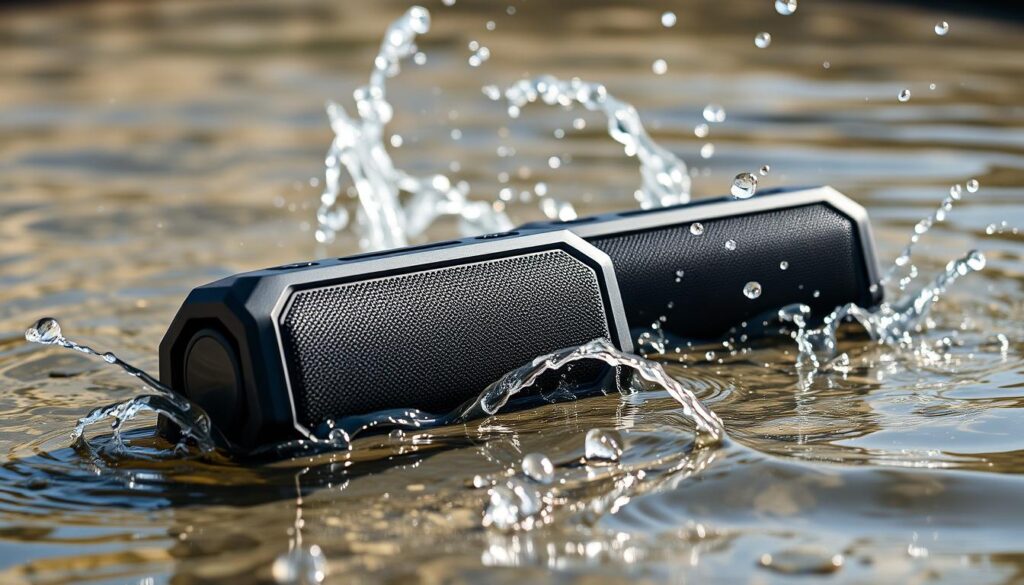
IP Rating System Explained
The IP (Ingress Protection) rating system shows how well a device guards against solids and liquids. It’s a two-digit code. The first digit is for solid protection, and the second is for liquid protection. For water-resistant speakers, this rating is very important because it affects how well they work in wet conditions.
What Different Ratings Mean in Real-World Use
For example, a speaker with an IP67 rating can block dust and handle being underwater up to 1 meter for 30 minutes. Knowing these ratings helps you pick the right waterproof speakers for your needs. This could be for use by the pool or in rainy weather.
Limitations of Water Protection Claims
Even though IP ratings are helpful, they’re based on specific tests. Real-life situations can be different. Things like water pressure, temperature, and other substances can change how well a speaker resists water. So, even with a high IP rating, water-resistant speakers need to be handled carefully to last longer.
In summary, knowing about the IP rating system and its meaning for waterproof speakers can really help when buying and using them. It’s not just about the rating. It’s also about how you use and take care of the speaker.
Top Waterproof Speakers for Water-Prone Environments
Going to the beach, pool, or hiking? A waterproof speaker is a great companion. With many choices, picking the right one can be tough.
Budget-Friendly Waterproof Options
Looking for an affordable waterproof speaker? Brands like Anker and JBL have great options. They’re perfect for casual outdoor use.
When shopping for cheap waterproof speakers, look for an IPX7 rating. Also, check for long battery life and durable build. These ensure your speaker can handle drops or splashes.
Premium Water-Resistant Models
Want a top-notch speaker? Premium models have better sound, longer battery, and last longer. Bose and Beats are known for their high-quality water-resistant speakers.
These premium speakers also have cool features like wireless charging and voice assistants. Plus, they look great.
Specialized Speakers for Extreme Conditions
Need speakers for extreme weather? There are models made for heavy rain or full submersion. These waterproof speakers are for serious outdoor fans and workers.
They have tough designs, better waterproofing, and long batteries. Ideal for tough environments.
Preventing Future Water Out of Speaker Problems
To keep your speaker working well, it’s key to act early against water damage. Water and electronics don’t mix well, leading to expensive fixes or making your device useless.
Using protective cases and covers is a smart move. These items create a barrier against water. Choose a case made for your speaker and has a high IP rating for good water protection.
Protective Cases and Covers
A good protective case can greatly lower water damage risks. For example, a waterproof case is great for outdoor use like hiking or at the beach. Look for cases with IP67 or higher ratings to ensure they can handle being underwater.
Optimal Speaker Placement
Where you place your speaker matters a lot. Don’t put it near water like pools, bathtubs, or sinks. If it’s in a humid spot, like a bathroom or kitchen, keep it away from water. Using a speaker stand or mount helps keep it dry.
Maintenance Routines for Moisture Prevention
Keeping your speaker dry is crucial. Regularly check your speaker for moisture or water signs. Clean it with a dry cloth, focusing on areas where water might get in. Also, make sure there’s air around your speaker to avoid humidity.
By following these steps, you can greatly lower the chance of water damage to your speaker. Protecting your device is not just about saving money; it’s also about keeping it working well.
Insurance and Warranty Considerations for Water Damage
Knowing your insurance and warranty options is key when dealing with water damage. As a speaker owner, understanding these can help protect your investment. It’s all about making informed decisions.
Coverage Limitations of Standard Warranties
Most standard warranties don’t cover water damage well. They often exclude accidental submersion or moisture exposure. Always check your warranty to see what’s included and what’s not.
| Warranty Type | Water Damage Coverage | Additional Benefits |
|---|---|---|
| Standard Warranty | Limited or No Coverage | Basic Repair or Replacement |
| Extended Warranty | Enhanced Coverage for Water Damage | Additional Services like Accidental Damage |
| Premium Warranty | Comprehensive Water Damage Coverage | Priority Support and Extended Services |
Benefits of Extended Protection Plans
Extended protection plans offer better coverage for water damage. They give you peace of mind and financial security. These plans also include extra perks like accidental damage coverage and priority support.
Making Successful Claims
To successfully claim, document the damage well. Take photos of the damaged speaker and keep records of all talks with the manufacturer or insurer. Knowing the claims process and having all your documents ready can make things easier.
Tips for Successful Claims:
- Document the damage with photos and detailed descriptions.
- Keep records of all correspondence.
- Understand the claims process and required documentation.
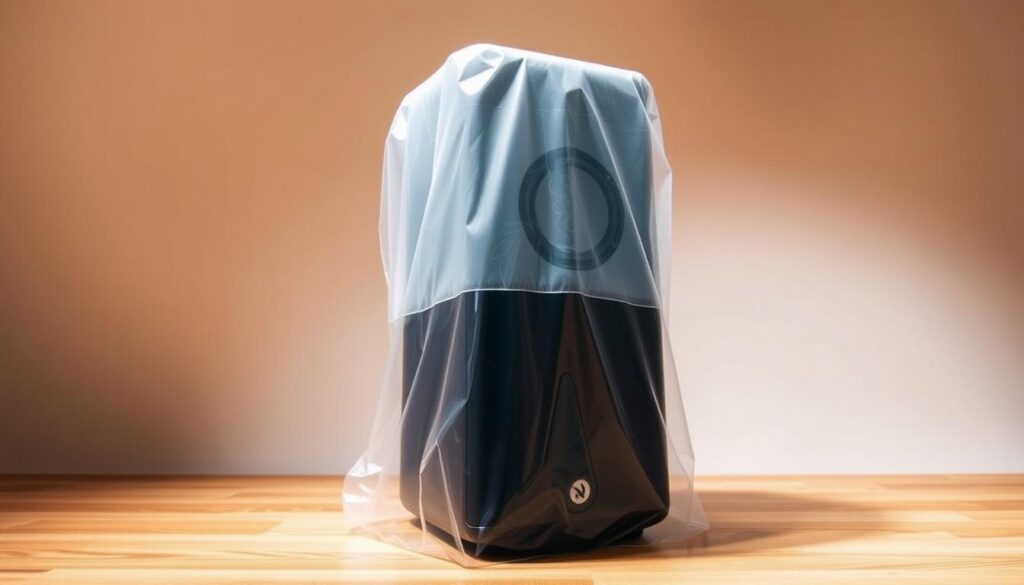
Conclusion
Dealing with water in your speaker can be really frustrating. But, knowing why it happens and how to fix it can make things better. We’ve looked at how water affects speakers, why it damages them, and how to get rid of it.
By following the steps we’ve shared, you can fix your speaker and avoid future problems. Using sound waves, drying methods, and special techniques for different devices can help. Also, keeping your speaker clean and using protective cases can help prevent water damage.
Knowing about water-resistant and waterproof speakers is also key. Look for IP ratings when buying a speaker. This way, you can pick a speaker that’s right for you and enjoy music without worrying about water damage.
FAQ
How can I tell if my speaker has water damage?
Look for signs like distorted audio or muffled sound. Also, check for visible moisture like water droplets or corrosion.
What should I do immediately after my speaker gets wet?
First, power down the device. Then, remove any batteries or power sources. Gently remove water by tilting or tapping.
Can I use a hair dryer to dry out my water-damaged speaker?
No, using a hair dryer is not recommended. It can push moisture further into the speaker or damage components. Instead, use air drying methods or desiccants.
Are there any apps that can help remove water from my speaker?
Yes, there are apps that play sound frequencies to help expel water. These can be a useful tool along with other drying methods.
How can I prevent water from getting into my speaker in the future?
Use protective cases or covers. Place speakers in optimal locations to avoid water exposure. Regular cleaning and inspection can also help prevent moisture buildup.
What is the difference between water-resistant and waterproof speakers?
Water-resistant speakers can handle some water but aren’t fully submersible. Waterproof speakers can be fully submerged for a while. Check the IP rating for details.
Can I repair a water-damaged speaker myself?
For minor damage, DIY repairs like cleaning corrosion or replacing basic components might work. But for severe damage, it’s best to seek professional help.
How do I know if my speaker’s warranty covers water damage?
Check your warranty documentation for specifics. Standard warranties often have limitations on water damage. Extended protection plans may offer more coverage.
What are some top-rated waterproof speakers?
Top-rated waterproof speakers include models from JBL, UE, and Bose. They offer a range of options from budget-friendly to premium, based on your needs and preferences.
Is the rice method effective for drying out a wet speaker?
The rice method can be somewhat effective, but it’s not foolproof. Using desiccants or air drying might be more reliable for drying out water-damaged speakers.
